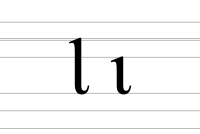Latin iota
Appearance
| Ɩ | |
|---|---|
| Ɩ ɩ | |
 | |
| Usage | |
| Writing system | Latin script |
| Type | Alphabetic and Logographic |
| Unicode codepoint | U+0196, U+0269 |
| History | |
| Development |
|
| Other | |
| Writing direction | Left-to-Right |
This article needs additional citations for verification. (December 2009) |

Latin iota (majuscule: Ɩ, minuscule: ɩ) is a letter of the Latin alphabet, based on the lowercase of the Greek letter iota (ι).
It was formerly used in the International Phonetic Alphabet to represent [ɪ] (the vowel in English "bit"). It was replaced by a small capital I (ɪ) in 1989, but it can still be found in use in some later works. Other variations are used for phonetic transcription:[1] ⟨ᵼ⟩, ⟨ᶥ⟩.
Ɩ has been adopted as a letter in the alphabets of some African languages, such as Gurunɛ, Kabiyé or Mossi. Its capital form has a hook to distinguish it from capital I. The accented italic form ɩ is very often indistinguishable from the italic letter small I i in serif fonts.
References[edit]
- ^ Constable, Peter (2004-04-19). "L2/04-132 Proposal to add additional phonetic characters to the UCS" (PDF).
